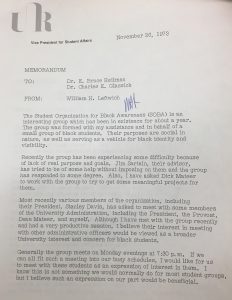 On November 26, 1973 then-vice president of student affairs, William H. Leftwich, sent a memo to university president, Dr. E. Bruce Heilman and provost, Dr. Charles H. Glassick, concerning the Student Organization for Black Awareness (SOBA). According to Leftwich, SOBA had been in existence for about a year and was formed with his help and continued under the guidance of sociology professor Dr. James Sartain. Leftwich noted that the group aimed to serve as a “vehicle for black identity and visibility” on campus but in his opinion lacked “real purpose and goals.” Despite having stated the group’s purpose in the previous paragraph, Leftwich’s assertion that the group lacked real purpose suggests that he did not consider their claims to a shared identity as a legitimate cause for group formation. In the memo Leftwich added that he had asked Richard Mateer, the dean of Richmond College, to help the group get some “meaningful projects” off the ground.
On November 26, 1973 then-vice president of student affairs, William H. Leftwich, sent a memo to university president, Dr. E. Bruce Heilman and provost, Dr. Charles H. Glassick, concerning the Student Organization for Black Awareness (SOBA). According to Leftwich, SOBA had been in existence for about a year and was formed with his help and continued under the guidance of sociology professor Dr. James Sartain. Leftwich noted that the group aimed to serve as a “vehicle for black identity and visibility” on campus but in his opinion lacked “real purpose and goals.” Despite having stated the group’s purpose in the previous paragraph, Leftwich’s assertion that the group lacked real purpose suggests that he did not consider their claims to a shared identity as a legitimate cause for group formation. In the memo Leftwich added that he had asked Richard Mateer, the dean of Richmond College, to help the group get some “meaningful projects” off the ground.
After introducing SOBA, Leftwich went on to ask, on behalf of the group, if Heilman and Glassick would be willing to meet with them. He acknowledged that student meetings with administrators were not typical but emphasized that it “would be viewed as a broader University interest and concern for black students.” Leftwich presented the meeting as a symbolic gesture and did not indicate that it would be anything beyond “an expression of interest.” It is interesting that Leftwich posited the meeting as a mere expression of interest in black students even though high-level administrators were invited to participate in the conversation. As president, Dr. Heilman in particular had the authority to bring about broad-sweeping change to the university or at the very least present possible changes to the Board of Trustees. His presence at the meeting had the power to be more than symbolic.
The proposed meeting offered a chance to hear directly from black students, implement new policies, and make the university better but instead that opportunity was squandered for the sake of symbolism. It is great that black students had the chance to be heard but it seems as though their grievances might have fallen on deaf ears. The demographic composition of the proposed meeting showed an inherent defect in the university system. All of the invited administrators were white men. At the time there were no full-time black faculty or high-level staff at the school. Black students were made to plead their case to those who may have been sympathetic to their cause but not at all familiar with their struggle. This memo implies that the administration was unwilling to seriously consider the plight of black students at the school and instead chose to make symbolic concessions.
